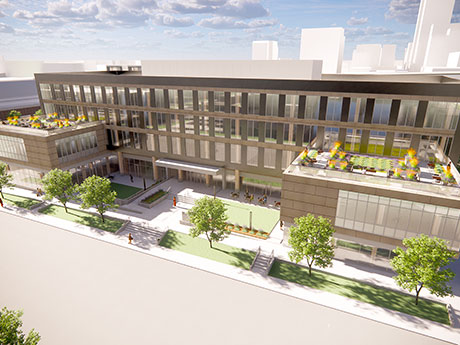By Kristi Andersen and Melissa Torrez, CBRE
The office market remains one of the most uncertain commercial real estate sectors across the country. Facing declining asset values, rising interest rates and the increase of remote and hybrid work, many of the nation’s office markets are struggling.
Key indicators that typically track the health of the market include net absorption, rental rates and vacancy rates. Not surprisingly, given the recent challenges, net absorption of office space nationwide is currently negative, rents have gone down and vacancy is high.

However, Omaha continues to buck those trends.
A solid, steady economy
The midwestern city boasts a diverse economy with agriculture, food processing, insurance, transportation, healthcare and education all being leading drivers. Warren Buffett calls Omaha home, as do several Fortune 500 corporations such as Berkshire Hathaway, Union Pacific Railroad, Mutual of Omaha and Peter Kiewit Sons’ Inc.
The Omaha economy consistently outperforms other metro areas, particularly during economic downturns. In December, the U.S. Bureau of Economic Analysis released 2022 Gross Domestic Product (GDP) data for counties and metropolitan areas. Douglas County, the most populous county in Nebraska, had the highest annual GDP growth at 9.2 percent for U.S. counties with populations greater than 500,000. These gains occurred while the world, the nation and the commercial real estate market were in the midst of a global pandemic.

Current conditions and future forecasts in this Midwestern city are positive. According to a report completed in October 2023 by the Omaha branch of the Federal Reserve Bank of Kansas City, Nebraska has posted annual job growth of 2 percent, while the unemployment rate remains among the lowest in the nation. As a result, hourly earnings in Nebraska have been rising an average of more than 5 percent annually since 2019. The report found that from the start of the pandemic to the first quarter of 2023, Nebraska led the nation in real inflation-adjusted personal income growth.
Chipping away at vacancy and increasing net absorption
Due to this strong and steady economy, Omaha rarely sees the highs or the lows other markets experience. This is evident in the city’s office market.
According to CBRE, the national office vacancy rate rose to a record-breaking 18.6 percent in the fourth quarter of 2023, which is the highest rate in 30 years.
Yet, Omaha’s office market is currently operating with a vacancy rate of 9.3 percent, making it one of the healthiest in the country.
Omaha also ended 2023 flat with total annual net absorption at 3,032 square feet. Two medical staffing companies, Fusion Medical and Prime Time Healthcare, were responsible for much of the net absorption leasing in the market with 128,200 square feet and 101,283 square feet, respectively.
While landlords in many markets saw rents fall, Omaha’s average asking lease rental rates now stand at $25.80 per square foot on a full-service gross basis. This is a slight increase of 0.2 percent quarter-over-quarter, and 2.9 percent year-over-year.
Even as investors dealt with higher interest rates, Omaha saw office sales volumes rise 35.9 percent from 2022 to 2023.
Keeping an eye on sublease space
With key indicators of vacancy, net absorption and rental rates at healthy levels, local experts are keeping a close eye on the amount of sublease space in the market, which currently represents 2.4 percent of total office inventory in the Omaha metro area. Available sublease space has continued to decrease and is currently at 593,342 square feet, which is much lower than the 1 million square feet available at the end of 2022 and 110,954 square feet lower than the end of 2023.
However, more than 300,000 square feet of available sublease space is set to expire in the next two years, which local experts fear could increase the overall office vacancy in the market if not absorbed.
Flight to quality
Like many cities across the country, Omaha employers are looking for a way to attract and retain talent, particularly with the low unemployment rate. With this in mind, the demand for high-quality, amenity-rich Class A office space is in high demand.
This trend can be seen in Omaha’s latest figures. Class A office space has a vacancy rate of 7.1 percent and an annual rent growth of 8 percent. Class B office properties show a vacancy rate of 10.4 percent, accounting for 67 percent of the available sublease space, and rents are up just 2.8 percent.
Construction pipeline could pose a problem
As demand for office space slows, new construction nationally has fallen to the lowest levels since 2012. Omaha has also experienced this trend, and the demand for high-quality space will likely outpace the supply.
For the fourth quarter in a row, there is just one speculative multi-tenant office property currently under construction in the Omaha market. The Builder’s District, a new mixed-use project in downtown Omaha, has a four-story, Class A, 107,943-square-foot office building for lease. Additionally, no multi-tenant office properties have been delivered to the Omaha market in four quarters.
Despite these challenges, Omaha’s office market continues to outperform its peers across several metrics. Out-of-market investors and companies are taking notice, making Omaha one of the most attractive cities in the nation for business.
Kristi Andersen is a vice president and Melissa Torrez is a senior field research analyst with CBRE. This article originally appeared in the April 2024 issue of Heartland Real Estate Business magazine.


